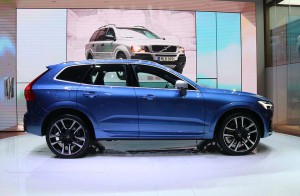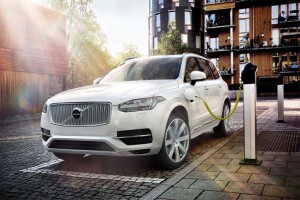With the roll-out of its premium line-up complete, Volvo is now moving on to higher-volume mainstream models, such as the new XC60 utility vehicle making its debut this week at the Geneva Motor Show.
Buoyed by strong sales of the crossover, sedan and wagon versions of its 90-Series, Volvo officials are betting the brand has finally regained some much-needed momentum, and are betting on an assortment of upcoming products to keep that going, including the even smaller 40-Series that will start rolling out at the end of 2017.
All three product families will be critical to the Swedish brand’s long-term future, and to the continuing support of Chinese parent Geely, which purchased Volvo from Ford Motor Co. in 2010. Geely has placed an $11 billion bet on Volvo, an investment that includes not only two new plants in China, but also another in the U.S. that will come on line during the second half of 2018.
The S60, the sedan version of the 60-Series, will be the first product to roll out of the plant in Charleston, South Carolina, noted Lex Kerssemakers, president of Volvo’s U.S. operations, during an interview following the XC60’s Geneva debut.
Initial production will be slow, about 15 sedans an hour, or 60,000 a year, though “We have the potential to go to 30 (an hour or an annual) 100,000,” said Kerssemakers. That’s modest by today’s automotive standards, but it’s also just the beginning. Sometime in the coming year, he revealed, Volvo will decide on the next product it will add to Charleston.
While the final choice hasn’t been made, “Pretty predictably, in the U.S., I would say I would want an SUV,” Kerssemakers said, in line with the shift in demand that now sees SUVs, pickups and other light trucks account for about two-thirds of total American new vehicle demand.
Volvo saw a huge plunge in demand during its final years of Ford ownership, something critics blamed on a lack of investment in new product. Things really only started to turn around towards mid-decade, Volvo posting large gains in 2014 and 2015. But U.S. sales slipped, unexpectedly, last year, and Kerssemakers blames that almost entirely on a shortage of the big Volvo XC90s, the ute that was named North American Truck of the Year in January 2016.
(Volvo exec reveals that an IPO is an “option.” Click Here for the story.)
“It was a pure supply issue,” he explained, noting that the U.S. had to share a limited supply of the XC models with other markets.
It will take some time to ramp up production of the smaller XC60, and the next XC40 won’t be ready for sale until roughly a year from now, but Volvo is counting on them to further build momentum.
The mix of sedans and utes and, to a lesser degree, wagons, is a safe bet in today’s U.S. market. Formerly a senior product planner in Sweden, Kerssemaker said he’d love to bring back the convertibles and coupes that once served as brand halo models, “but would they make a big difference? No.” The three series line-up now in position covers virtually all segments that Volvo needs to play in, he believes.
The one new bet that Volvo will be placing sees it move deeper into electrification. The XC90 brought the introduction of Volvo’s T8 engine option, and in a move just now being copied by competitors, the plug-in hybrid was developed to be Volvo’s high-performance package, not its mileage miser.
Come the 2019 calendar-year, Volvo will take the next step, introducing its first pure battery-electric vehicle. Kerssemakers declined to discuss specifics. He did, however, emphasize that “range will be what we need in the U.S. … which will start at 250 miles.” That’s slightly more than what the new Chevrolet Bolt EV delivers, and in line with some versions of the Tesla Model S, such as its 70d.
Reading between the lines, it appears some key decisions have not yet been made, even down to which product will get the electrified powertrain. But Kerssemaker seems to be favoring the 60- or 40-Series products, insisting that to be competitive in the U.S., “You should stick at $35,000 to $40,000 for your electric,” or about the price of the upcoming Tesla Model 3.
(Click Here for more about Volvo tailoring its City Safety System for rural roads.)
The initial Volvo EV will use the same SPA architecture underpinning the 60- and 90-Series models. That does have some drawbacks, as the batteries will take up some space normally dedicated to cargo and passengers. Going forward, the executive hinted, a dedicated platform could be in the works. Like the skateboard-like architectures in the Model 3 and Bolt EV, it would mount batteries in the floorboard and motors on the axles, actually increasing interior space compared to a conventional gas-powered vehicle.
What is clear is that there will be more battery-cars to come, Kerssemakers emphasizing that, “We strongly believe in electrification. We believe by 2025, electrified vehicles (including plug-ins and EVs) will be a significant part of our portfolio.”
That said, Kerssemakers said it will take time to get consumers to warm up to the technology.
Volvo also is betting on another potentially transformative technology: autonomous driving. It is already running several tests of self-driving vehicles, and it has supplied the XC90 utes being used in another pilot program run by Uber. The ride-sharing service is using its own software, but it is sharing data with Volvo, noted Kerssemakers, so, “we gain a lot of experience.”
Autonomous driving, he added, will be critical to achieving one of Volvo’s most cherished goals. Its Vision 2020 strategy envisions a time in the near future when no one riding in a new Volvo vehicle is killed or seriously injured in a crash.
“We cannot achieve that without autonomous driving,” he said.
(To see more about the new V60, Click Here.)
Volvo has already added extensive, semi-autonomous features to the 90-Series models, and it is expected to launch its first fully hands-free vehicles early in the coming decade.



